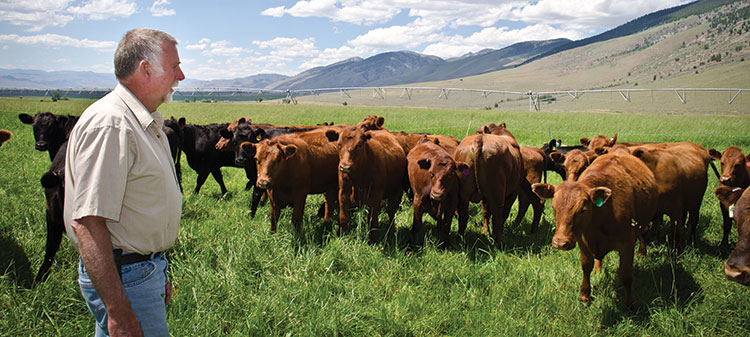The author is a freelance writer from Bozeman, Mont., and has her own communications business, Cowpunch Creative.

This past October, Jim Gerrish put on a three-day whirlwind tour of soil health workshops encompassing three cities across western Montana. The meetings were organized by a collection of sponsors, including the Soil and Water Conservation Districts of Montana.
A beef-forage systems expert with a lifetime of research and outreach experience, Gerrish shared his insight on the benefits of grazing management based on ecosystem processes and the paybacks it can give in the form of improved soil health.
In an almost philosophical manner, Gerrish explained that a grazing manager must not seek answers before understanding the questions they are asking in relation to their ecosystem.
“The question is not always what you think it is,” Gerrish said, “and the answer is rarely what you expect.”
Gerrish took workshop attendees back to the basics, covering grazing’s foundational principles. He described only four ingredients — carbon dioxide, solar energy, water, and soil minerals — are necessary for making meat, milk, and fiber. To effectively produce these end products from livestock, producers must manage pastures to be efficient solar panels, water catchments, and nutrient banks. This is accomplished, explained Gerrish, through managing grazing livestock more intensively and balancing strategies with the ecosystem processes involved.
Management-intensive grazing is about using your resources in space and time, noted Gerrish. In addition, it’s critical to understand that the carrying capacity of pastures is determined by the combination of environment and management. To get the most out of pastures, Gerrish recommended the following steps.
Step 1: Build a better solar panel. Only green, growing leaves carry out photosynthesis and it takes grass to grow grass, Gerrish expounded. Understanding plant growth cycles and how to manage forages for a compromise of both adequate quality and yield are essential. Leaf stage and growth phases, he pointed out, are more important criteria to observe than plant height, when it comes to grazing.
Grazing when grass plants are in Phase 2, during stem elongation and preboot stage, offers the greatest photosynthetic efficiency in the growth cycle. Gerrish noted grazing too early in the growth cycle is the leading cause of lost pasture production.
Step 2: Manage for a healthy water cycle. Before one can manage for a healthy water cycle, Gerrish said producers need to establish a baseline for average moisture accumulation in their area. He recommended using historic weather records to determine long-term precipitation. This information can be found on several online weather websites such as the National Oceanic and Atmospheric Administration and NRCS’s National Water and Climate Center.
According to Gerrish, lack of a healthy water cycle leads to:
- Reduced vegetative cover (bare ground)
- Diminished root growth
- Declining organic matter
- Poor soil structure
- Compacted soil
- Restricted infiltration
- Poor water holding capacity
- Excessive runoff
To ensure an effective water cycle, Gerrish said graziers should control the amount of time livestock spend in one area and allow for sufficient recovery periods in balance with environmental conditions. Doing so will ensure optimal vegetative cover and an adequate litter layer on the soil. At the same time, soil organic matter and health are improved.
Step 3: Create a dynamic mineral cycle. In grasslands, Gerrish described that nutrients flow in a cycle. Inputs from mineralization, the atmosphere, fertilizer, animal manure, and plants go in and products such as hay or meat, milk, and fiber come out. This nutrient cycle becomes more consistent and well distributed when livestock are grazed at higher stocking densities and moved to new forage more frequently.
Step 4: Enhance biodiversity. Gerrish explained that a biodiversity of plant species in pastures brings a multitude of benefits to livestock producers. Increased photosynthesis per acre leads to greater forage production. In addition, multiple types of plants ensure pastures offer a more balanced diet and uniform forage supply throughout the year. The added perks don’t stop at the soil surface, however, said Gerrish. Below ground, a diverse plant community leads to a greater diversity of soil microbial life. This plethora of pasture plants also provides better wildlife habitat and ecological stability.
Producers can create greater diversity in pastures by selecting a combination of both complementary and competitive forages. This means selecting species from each functional group — grasses, legumes, and forbs. For example, on his Idaho grass-finishing operation, Gerrish said he grazes his cattle on pastures containing everything from tall fescue, orchardgrass, red clover, and yellow sweet clover to cheatgrass, downy brome, and dandelion.
To maintain plant diversity, Gerrish said he varies his pastures’ season of use by alternating each year between grazing during growing and dormant seasons and observes appropriate recovery periods depending on environmental conditions. Additionally, he said his experience has shown, similar to maintaining a diversity of plants, multispecies grazing can also be a helpful tool in maintaining pasture biodiversity above and below the soil surface.
Learn more about Gerrish’s work at www.americangrazinglands.com.
This article appeared in the February 2017 issue of Hay & Forage Grower on page 20.
Not a subscriber? Click to get the print magazine.

